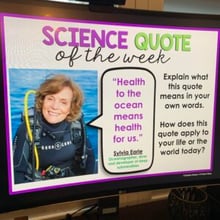Sexual and Asexual Reproduction Activities
for Middle School Science
The resources below will provide students a comprehensive understanding of sexual and asexual reproduction. All of the following lessons are also included in the Kesler Science Membership.
The Sexual and Asexual Reproduction 5E Lesson includes materials for every "E" phase, including the Sexual and Asexual Reproduction Station Lab for Exploration and an interactive PowerPoint with digital INB templates for Explanation.
The lesson also includes introduction materials for Engagement, student-choice project ideas for Elaboration, and assessments for Evaluation.
After completing the Sexual and Asexual Reproduction 5E Lesson, students will be able to compare and contrast sexual and asexual reproduction. They will also be able to identify vegetative propagation, binary fission, budding, and fragmentation.
The Sexual and Asexual Reproduction Inquiry Lab is a hands-on activity that is differentiated for advanced, on-level, and modified middle school students.
In this lab, students will observe the genetic results of both asexual and sexual reproduction by conducting a simulation in which they create a new school mascot.
The Sexual and Asexual Reproduction Inquiry Lab includes a brief reading passage, comprehension checks, hands-on activities, reflection questions, and a CER conclusion.
Year-Round Resources
These year-round activities will increase your students' understanding of many middle school science topics. All of these activities are also included in the Kesler Science Membership.
Visual Data & Graphing
You're not alone if your students struggle with understanding graphs, charts, and tables. It's a skill that takes an enormous amount of practice. This resource will help students build a strong foundation in analyzing data and creating their own data visualizations.
Bell Ringers and Warm-Ups
These middle school science bell ringers are an excellent way to engage your students as soon as they walk into your classroom. This comprehensive FULL YEAR resource includes everything you need to start off each science class with an interesting warm-up activity.
Review Board Games
Each game board has been carefully designed to keep students engaged. There are 10 different action spaces on each board and dozens of question cards. All of the actions are related to science concepts and keep the students motivated throughout the game.
Each game is ready to play. Simply print out the board and the cards and let the students enjoy reviewing nine different units.
Essential Questions and Standards
Below are the essential questions and standards associated with the lessons and activities included in the sexual and asexual reproduction unit. This topic is only one of more than 100 middle school science topics included in the Kesler Science Membership.
-
How are sexual and asexual reproduction comparable?
-
What types of reproduction produces uniform and diverse offspring?
-
How is genetic information passed from parents to offspring?
-
MS LS1-4 - Use argument based on empirical evidence and scientific reasoning to support an explanation for how characteristic animal behaviors and specialized plant structures affect the probability of successful reproduction of animals and plants respectively
-
MS LS3-1 - Develop and use a model to describe why structural changes to genes (mutations) located on chromosomes may affect proteins and may result in harmful, beneficial, or neutral effects to the structure and function of the organism
-
MS LS3-2 - Develop and use a model to describe why asexual reproduction results in offspring with identical genetic information and sexual reproduction results in offspring with genetic variation
-
MS LS4-4 - Construct an explanation based on evidence that describes how genetic variations of traits in a population increase some individuals’ probability of surviving and reproducing in a specific environment
-
TEKS Science 6.12 D - Identify the basic characteristics of organisms, including prokaryotic or eukaryotic, unicellular or multicellular, autotrophic or heterotrophic, and mode of reproduction, that further classify them in the currently recognized kingdoms
-
TEKS Science 7.14 B - Compare the results of uniform or diverse offspring from asexual or sexual reproduction
Kesler Science Membership
Imagine never having to search for another middle school science lesson again. The membership gives you access to ALL of the Kesler Science products in one place (Yes, including everything above).
Say goodbye to long hours of lesson prep.

